by John Semlak | Jun 22, 2016 | #NYCHistory

Stain glass window at Sage Chapel at Cornell University, Schwerner’s Alma Mater
On 21 June 1964, Mickey Schwerner, Andrew Goodman, and James Chaney traveled to the Mount Zion Methodist Church near Philadelphia in Neshoba Country, Mississippi. Schwerner and Chaney had been there a month previously the encourage the congregation to set up a Freedom School and encourage local African-Americans to vote. While they were at an activist training camp for the 1964 Freedom Summer campaign in at the Western College for Women in Oxford, Ohio (now Miami University), they learned the church was burned down by the Ku Klux Klan. They drove down to investigate.
After witnessing the destruction and speaking to its congregation, the three activists began a drive to Meridian, a nearby town where the organization, CORE (Congress of Racial Equality) had a base. Neshoba County was considered dangerous for Civil Rights workers (even by Mississippi standards). They had a flat and were then pulled over by Neshoba County Deputy Sheriff Cecil Price. The three were arrested for speeding and held for several hours but then released. They began a drive back to Meridian. Before they got out of the county they were pulled over by Cecil Price again. This time he was with a lynch mob of over a dozen KKK members. The three CORE activists were killed. They were murdered for helping African Americans register to vote.
Schwerner and Goodman both came from a New York Jewish tradition of social activism (which also produced 2016 presidential candidate Bernie Sanders) and were among many who traveled to the South to work for greater social justice. Andrew Goodman grew up on 86th Street on the Upper West Side and was a classmate with Paul Simon at Queens College. Schwerner grew up in Pelham, New York in Westchester County. He started his social activism at the ‘Downtown CORE in the Lower East Side in Manhattan.
Another activist from New York was Robert Parris Moses (not that Robert Moses). Moses was from Harlem and graduated from Stuyvesant High School and Hamilton College and became a field secretary at the Student Non-violent Coordinating Committee and was later co-director of COFO (Council of Federated Organizations), an umbrella organization for civil rights groups and based in Mississippi. He was one of the primary organizers of the Freedom Summer project. When the workers Chaney, Schwerner and Goodman went missing, he gathered the rest of the workers in his office told them that this was the risk they were taking they could leave. All the workers chose to stay.
Outrage over the murder of the three workers nationwide helped galvanize opinion nationwide and helped lead to Civil Rights Act of 1964 and the Voting Rights Act of 1965.
 Historic marker of the murder location, at a small rural road called Rock Cut Road
Historic marker of the murder location, at a small rural road called Rock Cut Road
by John Semlak | Jun 18, 2016 | #NYCHistory
 16th-century tapestry illustrating an Iranian arms workshop
16th-century tapestry illustrating an Iranian arms workshop  Pole arms and armor from the Arms and Armor exhibit
Pole arms and armor from the Arms and Armor exhibit
For young visitors, as well as a certain kind of geek, one of the most popular exhibits at the Metropolitan Museum of Art is the Arms and Armor exhibit, which features historic weaponry from as early as the 14th century. While mostly from late Medieval and Renaissance Europe, the exhibit als contains arms from Asia and the Americas, including early firearms. In the future the exhibit will be the subject of a more extensive post on this blog. However, currently adjacent to the main Arms exhibit is a temporary exhibit on weapons from the Muslim world, on view until 2 Jan 2017.
 18th century Persisn weapons
18th century Persisn weapons  From 19th-century Sudan
From 19th-century Sudan
The special exhibit is in conjunction with a book on the subject just published by the Met. Though most objects are from the 16th – 19th centuries, one Iranian sword dates from the 9th century. Several weapons look more ceremonial than combat-worthy, featuring encrusted jewels and beautiful scabbards. For medievalists and weapons enthusiasts it’s an essential stop at the Met. It’s room #380 and it’s just East of the Arms and Armor exhibit on the 1st floor.
 Ottoman saber and helmet from the 16th century.The weapons bear Arabic inscriptions.
Ottoman saber and helmet from the 16th century.The weapons bear Arabic inscriptions.
Remember that all exhibits at the Met are viewable with the museum’s general admission, which is pay-as-you-wish. See the museum website for visiting information.
 19th century Iranian mace and dagger
19th century Iranian mace and dagger  19th century Algerian flintlock pistols
19th century Algerian flintlock pistols
by John Semlak | Jun 9, 2016 | #NYCHistory
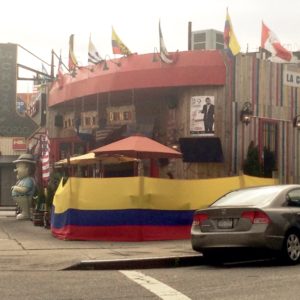
La Choza del Gordo in Long Island City in Queens
The Copa America is already underway. As I write this post we’re almost midway through the group stage involving all 16 teams. Then we move to the quarterfinals and beyond. The first match in the NY metro area will be on June 12th.
But you can experience the madness right here in New York City. Supporters of Team USA and the 15 other North and South American nations abound in NY and are packing various bars and restaurants to watch the matches.
In general it is best to simply go to a neighborhood where many of the first or second-generation immigrants from the nations playing live. The best area is Jackson Heights in Queens, an area with many South American immigrants and very vibrant during soccer tournaments involving them.
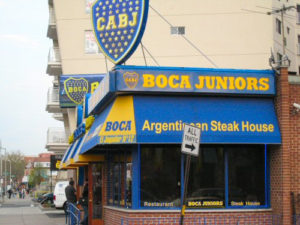
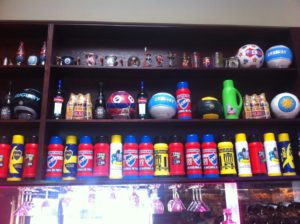
Football memorabilia inside La Gran Uruguaya
Two particular places I recommend are La Gran Uruguaya and Boca Juniors–both in Queens. La Gran Uruguaya, in Jackson Heights, is devoted to Uruguayan football. It is a bakery and a bar. Inside is Uruguayan soccer memorabilia. It is a fine place to watch any soccer match and attracts fans of many teams.
Boca Juniors, a steakhouse in Elmhurst on Queens Boulevard named after Argentina’s most famous soccer club. It’s absolutely packed during Argentina games and often features a band during big matches.
Here are some of the better places to watch the matches, sorted by country:
General soccer-friendly bars, and good for USA matches:
Legends: 33rd and 5th.Manhattan
Smithfield Hall NYC 138 W 25th St Manhattan
The Weir, 3rd Ave and 93rd St, Manhattan
Banter, 132 Havemeyer St, Williamsburg, Brooklyn
Woodwork, 583 Vanderbilt Ave, Prospect Heights Brooklyn
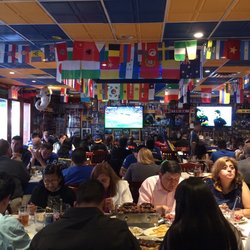
Boca Juniors during the 2014 World Cup
Argentina:
Boca Juniors, 81-08 Queens Blvd, Queens
Bolivia
Renacer, 67-03 Woodside Ave, Woodside, Queens
Brazil
Miss Favela, 57 S 5th St, Williamsburg, Brooklyn
Chile
San Antonio Bakery 3620 Astoria Blvd, Astoria, Queens
Colombia
El Basurero, 32-17 Steinway St, Astoria, Queens
El Abuelo Gozon, 79-03 Roosevelt Ave, Jackson Heights
Costa Rica
Olga’s Place, 214 LT Glenn Zamorski Dr, Elizabeth, NJ
Ecuador
Pequeno Coffee Shop, 8610 Roosevelt Ave, Jackson Heights, Queens

El Paso decorated for the 2014 World Cup
Mexico
Campeon, 9 E 16th St (15th and 5th), Manhattan
El Paso Restaurant, Lexington and 104th, East Harlem, Manhattan
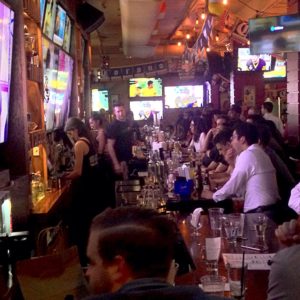
Mexican fans watching El Tri, the national team, at Campeon on 16th Street.
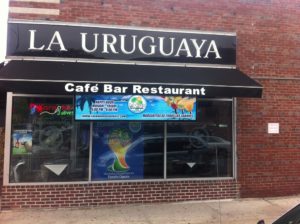
La Gran Uruguaya in Jackson Heights
Panama
Kelso, 648 Franklin Ave, Prospect Heights, Brooklyn
Paraguay
I Love Paraguay, 4316 Greenpoint Ave, Sunnyside, Queens
Peru
Amaru Bar, 84-13 Northern Blvd, Jackson Heights, Queens
Uruguay
La Gran Uruguaya, 85-06 37th Ave, Jackson Heights, Queens
Venezuela
Patacon Pisao, 85-22 Grand Ave, Elmhurst, Queens
by John Semlak | May 21, 2016 | #NYCHistory
Earlier this year in England the football club Leicester City completed a remarkable title run to the Premier League title. It was classic Cinderella tale by a small club and a feat considered impossible by experts. The conversation sparked comparisons with other unlikely champions. The 1980 US Olympic hockey team was mentioned, as was the Greece football team at Euro2004. But one was not mentioned that ought to have been. In 1983 an Australian ship Australia II broke a 132-year winning streak, defeating the New York Yacht Club in the America’s Cup–the pinnacle of the sport of sailing. It remains one of the most dramatic events in sports history.
The America’s Cup was first held in 1851, a race (or ‘regatta‘) around the Isle of Wight in England won by the ship America of the New York Yacht Club. The NYYC would defend the trophy, called the ‘Auld Mug’ 25 times. The regattas were hosted by the NYYC, first in New York Harbor and later at NYYC’s Harbour Court clubhouse in Newport Rhode Island. Challengers for the America’s Cup came from counties in the English-speaking world such as Britain, Canada and Australia.

The America’s Cup, called the ‘Auld Mug’.

A Currier and Ives picture of a New York Yacht Club Regatta in 1869 in New York Harbor.
In the 2nd half of the 20th century, Australia began to send several strong challengers for the America’s Cup and the race generated serious interest Down Under. A wealthy businessman from Western Australia named Alan Bond began to finance challenges in an attempt to wrest the cup. He failed three times. in 1977 he was defeated by the ship Courageous skippered by Ted Turner. But in 1983, he tried again, this time sending a golden wrench along to unscrew the cup from his place.
The 1983 America’s Cup was held in Newport and was a best of 7 sailing race. (over the years the series has varied from a single race to as many as 19 races) The Australian ship was the Australia II, while the American ship was the Liberty, captained by the skilled yachtsman Dennis Conner. The Liberty won three of the first 4 races and looked set to defend the Cup yet again. But Australia II won the next two races to even the series at 3-3 and set up a dramatic climax. On September 26th, 1983, the Australia II won the deciding race to take the America’s Cup from the New York Yacht Club for the first time in history. Australians, used to watching their teams compete abroad at odd times, watched the race in the late hours of the night. Prime Minister Bob Hawke famously said, “Any boss who sacks anyone for not turning up today is a bum”.
The New York Yacht Club has never regained the America’s Cup. In the 1987 America’s Cup (hosted in Fremantle, Australia), captain Dennis Conner returned to the race with the San Diego Yacht Club and won the America’s Cup. Today the Cup is held by the Golden Gate Yacht Club in San Francisco.
On May 7-8 2016 the America’s Cup returned to New York Harbor for the first time since 1920 in the form of the America’s Cup World Series, a preliminary competition in advance of the 2017 America’s Cup in San Francisco. 6 international teams competed. The event will be shown on NBC in recorded form at 2:00 p.m. EST on Saturday May 21st.
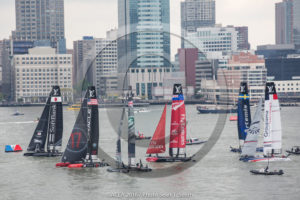
The America’s Cup in New York Harbor for the first time since 1920. Photo Americascup.com
The New York Yacht Club remains a proud private social club devoted to yachting, with their main clubhouse on 44th Street in Midtown as well as Harbour Court in Newport RI (a town where historically many wealthy New York families owned summer houses).. It was founded in 1844. Over the years, members have included many of New York’s financial elite and various celebrities including several Astors, JP Morgan, Walter Cronkite, Ted Turner, David Rockefeller, William Buckley, and Bernie Madoff. The original clubhouse was in Hoboken, New Jersey. (The small modest building has been moved several times and now is located in Newport.) Other clubhouses have been located various places in New York City. in 1901 they moved into their current club on 44th Street. The NYYC is one of New York’s oldest social institutions. It’s older than the West Side Tennis Club, the New York Police Department, the New York Yankees (or the Major Leagues for that matter), the NY YMCA, the Metropolitan Opera, the Metropolitan Museum, the Players Club, etc. It outlasted Tammany Hall and St George’s Cricket Club.
Here are several sites in New York related to the New York Yacht Club you can visit:

The 44th Street Clubhouse, built from 1899-1901

1. The 44th Street Clubhouse.
The NYYC’s clubhouse on 44th Street between 5th and 6th Avenues is one of the true architectural gems of the city. Opened and 1901, the Beaux Arts masterpiece was built by the firm Warren and Wetmore, who also built Grand Central Terminal. The limestone exterior has numerous nautical features including carvings meant to represent 17th century Dutch yachts. The interior is even more exquisite, featuring many many model ships and the general plush you you expect in an exclusive club. However, to get in one must be either a member or invited by one, except on rare days when it is open to non-members such as Open House New York. In any case, there’s a strict dress code (absolutely no denim) and photos are not allowed. Still, even if you can’t get inside, just the exterior is worth the trip. It’s just a few minutes walk from either Times Square or Grand Central.
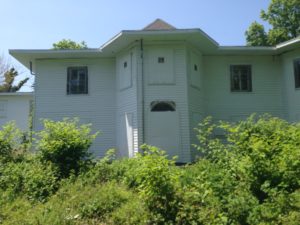
The McFarlane-Bredt House in Alice Austen Park. The building is currently closed for restoration.
2. The McFarlane-Bredt House at Alice Austen Park on Staten Island.
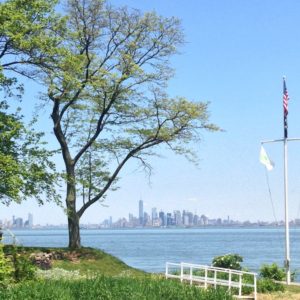
View of New York Harbor from near the McFarlane-Bredt House
This house built in the 1840s as a private home was purchased by the NYYC in 1868 and was their clubhouse for 3 years. From here, members watched the 1870 America’s Cup in New York Harbor, the first defense of the Cup. The building is an Italian-Swiss style villa and sits in Alice Austen Park, and until relatively recently was a residential building (after the NYYC sold the building in 1871 it was divided into 4 apartments). Unfortunately the building is fenced off today and is undergoing a slow restoration process. The park plans to eventually open it to the public as an exhibit on the NYYC. Still, Alice Austin Park is worth a visit, which also contains the late 1600s Alice Austen House, named after a famous Staten Island photographer who lived there. The park has stunning views of New York Harbor, Manhattan and the Verrazano-Narrows Bridge. The park is also near several attractions, including the Garibaldi Meucci Museum and Fort Wadsworth.

Hoboken Cove Boathouse, a recreation of the original NYYC clubhouse once located here.
3. Hoboken Cove Boathouse, Hoboken, NY
Located at the intersection of Frank Sinatra Drive and Sinatra Drive North, this is the original location of the first New York Yacht Club Clubhouse, founded in 1845. A plaque marks the site. The building there today is a recreation of the NYYC’s first clubhouse and is a place for kayaking lessons today. The original clubhouse still stands, but it was moved to Newport, RI, on the grounds of the NYYC’s Harbour Court Clubhouse.
 The mast of the Columbia, winner of the 1899 and 1901 America’s Cup
The mast of the Columbia, winner of the 1899 and 1901 America’s Cup
4. Mast of the Columbia, standing in Forest Hills Gardens in Queens.
At roughly 150 Greenway Terrace in the tranquil neighborhood Forest Hills Gardens stands a seemingly unlikely monument–the mast of Columbia, winner of two America’s Cups in 1899 and 1901. The flag was dedicated here by former President Theodore Roosevelt in 1917.

 Historic marker of the murder location, at a small rural road called Rock Cut Road
Historic marker of the murder location, at a small rural road called Rock Cut Road 16th-century tapestry illustrating an Iranian arms workshop
16th-century tapestry illustrating an Iranian arms workshop  Pole arms and armor from the Arms and Armor exhibit
Pole arms and armor from the Arms and Armor exhibit 18th century Persisn weapons
18th century Persisn weapons  From 19th-century Sudan
From 19th-century Sudan Ottoman saber and helmet from the 16th century.The weapons bear Arabic inscriptions.
Ottoman saber and helmet from the 16th century.The weapons bear Arabic inscriptions. 19th century Iranian mace and dagger
19th century Iranian mace and dagger  19th century Algerian flintlock pistols
19th century Algerian flintlock pistols














 The mast of the Columbia, winner of the 1899 and 1901 America’s Cup
The mast of the Columbia, winner of the 1899 and 1901 America’s Cup